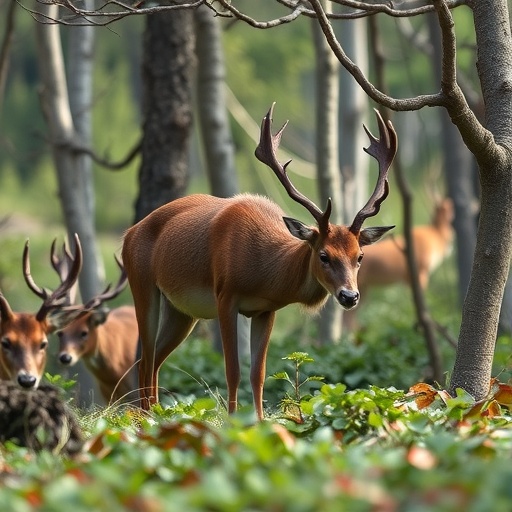Human-wildlife conflict (HWC) has emerged as a critical environmental issue, posing serious implications for both wildlife conservation and human livelihoods worldwide. The recent global systematic review by Adler, Gore, and Wilkinson provides an insightful analysis into the gendered dimensions of these conflicts, illuminating how the impacts are not distributed equally between men and women. As global human populations continue to expand, the encroachment into wildlife habitats has intensified, leading to more frequent and severe confrontations between humans and animals. This has sparked a growing concern among researchers, policymakers, and conservationists alike.
The systematic review highlights that women often bear a disproportionate burden in HWC scenarios, facing unique challenges that are seldom addressed in traditional conservation strategies. The authors meticulously examined numerous studies worldwide to gather data on how gender roles influence the experiences and responses to HWC. They found that women are more likely to depend on natural resources for their households, making them particularly vulnerable to the negative consequences of wildlife interactions. This dependence underscores the necessity of integrating gender perspectives into conservation and wildlife management policies.
Specifically, the review pointed out that women often engage in resource collection. This makes them more susceptible to encounters with dangerous wildlife such as elephants or large carnivores. While men are frequently involved in livestock herding or agricultural activities, it is the women who are usually responsible for gathering firewood, water, and other essential resources. Their roles place them in direct contact with wildlife, resulting in increased risks of injury and economic losses. The findings stress the importance of recognizing these gendered dimensions to create more effective management strategies that consider the specific needs and risks faced by women.
Moreover, the review also sheds light on the psychological impacts of HWC on women. Women often experience heightened levels of anxiety and stress due to the constant threat posed by wildlife. This emotional burden can manifest in numerous ways, including limitations on their ability to work or move freely within their communities. Their mental and emotional well-being is deeply intertwined with their physical safety. Hence, addressing these psychological ramifications becomes a crucial aspect of comprehensive strategies aimed at minimizing HWC.
The implications of gendered costs extend to economic aspects as well. The study revealed that women are often less likely to receive compensation for wildlife damage compared to men, further exacerbating their vulnerabilities. This disparity can lead to a vicious cycle of poverty and insecurity for women in affected regions. The authors argue that addressing these economic inequities is essential for fostering sustainable coexistence between humans and wildlife. Strategies to ensure equitable compensation mechanisms are necessary to mitigate the financial toll on women disproportionately affected by HWC.
Interestingly, the review also highlighted instances where women have played pivotal roles in wildlife conservation efforts. Local women’s groups have proven to be effective in fostering community-based conservation initiatives. Their unique understanding of local ecosystems and the socio-cultural dynamics at play can enhance conservation outcomes. By empowering women and harnessing their insights, conservation projects can become more inclusive and effective. This finding serves to emphasize that involving women in decision-making processes can yield beneficial results for both communities and wildlife.
The research underscores that integrating gender considerations into HWC management is not merely a recommendation but a necessity. Ignoring gender dynamics can lead to ineffective policies that fail to address the realities on the ground. The authors advocate for incorporating gender analysis into environmental assessments and policy formulations, arguing that such steps will lead to more holistic and sustainable solutions. The call for gender-responsive conservation strategies represents a significant advancement in how we address environmental challenges.
Additionally, the researchers recommended that local communities receive training and support to develop strategies that balance human needs and wildlife conservation. This approach could include diversifying livelihoods to reduce dependency on resources commonly targeted by wildlife. Furthermore, embracing innovative technologies and community-led initiatives can empower both men and women to cooperate in addressing HWC challenges. Collaborative efforts play a critical role in bridging the gap between conservation objectives and local community needs.
The systematic review by Adler and colleagues is a groundbreaking piece of scholarship, encouraging a re-evaluation of how gender is perceived within the context of wildlife conservation. It serves as a reminder that the path to sustainable coexistence is paved with inclusivity, engagement, and empowerment of all community members, especially women. As we deliberate on future conservation strategies, the inclusion of gendered perspectives will be vital in crafting equitable solutions that genuinely protect both human livelihoods and wildlife.
It is time for policy-makers, conservationists, and community leaders to prioritize the insights derived from this research. By acknowledging the gendered facets of HWC, there can be strides toward recognizing the complexity of human-nature interactions. The journey towards effective conflict management hinges on understanding these interconnected dynamics and fostering cooperation that benefits both people and wildlife. The implications of such an approach are profound and far-reaching, charting a course toward a more equitable and sustainable future for all.
In conclusion, human-wildlife conflict is an intricate issue that requires a nuanced understanding of gender roles. The findings from this systematic review remind us that effective conservation strategies must address the diverse experiences of individuals within communities. By acting on these insights, we can create more resilient communities that thrive alongside the natural world they inhabit. The resolve to combat HWC with a gender-aware approach holds the potential for transformative change and sustainable coexistence in our shared ecosystems.
Subject of Research: Gendered costs of human-wildlife conflict
Article Title: The gendered costs of human–wildlife conflict: A global systematic review
Article References: Adler, K.A., Gore, M.L. & Wilkinson, C.E. The gendered costs of human–wildlife conflict: A global systematic review. Ambio (2025). https://doi.org/10.1007/s13280-025-02300-y
Image Credits: AI Generated
DOI: 10.1007/s13280-025-02300-y
Keywords: Human-wildlife conflict, gender dynamics, wildlife conservation, systematic review, community engagement, sustainable solutions.




